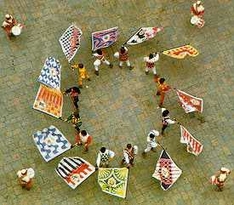
Volterra is a small town with rich history which goes back almost by three thousand years. The early stage of town development is connected with Etruscans. Now we may see the evidence of their presence not only in the richest museums but also in the town itself. Today you may pass through the famous Porto del Acro, which contain the image of three Etruscan gods and walk around Fortezza which embraces the town centre and seems to be endless. The grand tower above the cliff functions as jail till present days and surprisingly is not presented to tourists. Although in the very centre on the top of the hill you may observe the excavation of the Etruscan necropolis.
The town was well developed and thrived thanks to palatial forests, agriculture, cattle farming, copper and silver mining. Therefore it attracted many invaders. Volterra resisted thanks to its geographical position and fortifications but eventually surrendered to the mighty Rome. The relic of three buildings became the witnesses of that period. One of the buildings used to be the temple, which is now situated in on the archeological park not far from the fortress. Another place is the theatre ruins and finally inlaid thermae floors. The Roman period is characterized both by wealthy and brutal times. The town was threatened by new invaders. One of the legendary moments is dated by VI century a.d. when the siege was quit with the help of bishop who ordered the citizens despite the terrible hunger to throw bred down the city walls. Barbarian army withdrew presumably because of the fear that the siege would last for a long time or maybe it just was thankful for food. Nevertheless the Roman dominance had come to an end and Francs with Langobards became new masters.
By the XIII century Volterra had become an independent commune and neighboring Florence started to threaten its sovereignty. Despite civil discord this period gave birth to many historical monuments. Piazza dei Priori and Palazzo dei Priori - the symbol of the independence of commune, it is decorated with magnificent frescoes. It is the oldest administrative building which is preserved up to this day. It served as an example for creation of Palazzo Vecchio. Cathedral which is situated at San Giovanni square is worth visiting. Pinacotheca welcomes the amateurs of Florentine art. One of the important places to visit is Museo Etrusco Guarnacci founded in 1735 and named after bishop Guarnacci who granted his collection to the town. One of the best Etruscan pieces of art are presented here. Viale dei Ponti is the place which delights you with valleys hills and forests that surround Volterra.
See also

|
Festival of flags “Astiludio” in Volterra
Old Volterra invites to the festival of flags “Astiludio” on the first Sunday of September.The colorful festival alludes to the historic events of the XV century. On the 18th of October 1406 two couriers arrived in Volterra with the news that the Florentine troops had triumphed over the Pisans a couple of days before, on the 9th of October. At that time Volterra was an ally of Florence, so the news was taken jubilantly.
|
No comments